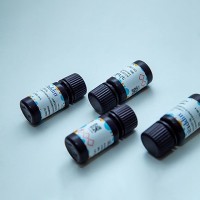The Use of Quantum Dots for Immunochemistry Applications
互联网
1137
Immunocytochemistry and histochemistry are two most valuable immunochemistry techniques routinely used in biological laboratories. These techniques rely on the use of antibodies to label epitopes of interest in cells. At present, there is a wide range of commercially available organic dyes for labeling antibodies. However, limited extinction coefficients of organic dyes often make it difficult to achieve the optimal exposure and therefore fluorescence detection limit. Quantum dots (QDs) are fluorescent semiconductor nanocrystals which are advantageous over the organic fluorescent dyes in many aspects, principally their long-term luminescence stability, high brightness, and multicolor detection. Here, we describe the use of QDs for immunocytochemistry applications. We used three different antibodies—anti-β-tubulin monoclonal antibody for visualizing the microtubule network, the GM130 antibody for staining the Golgi complex, and the EEA1 antibody for detecting the endosomal system. We use the anti-mouse IgG antibody directly conjugated to QD655 quantum dots or anti-mouse IgG conjugated to biotin for tertiary detection with streptavidin-conjugated QD655.





